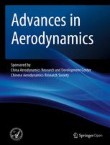Advances in Aerodynamics is affiliated with the Chinese Aerodynamics Research Society, which is supported by China Aerodynamics Research and Development Center.
Application of surrogate models to stability analysis and transition prediction in hypersonic flows
To increase the efficiency and robustness of stability-based transition prediction in flow simulations, simplified methods are introduced to substitute direct stability analyses for rapid disturbance growth pr...
